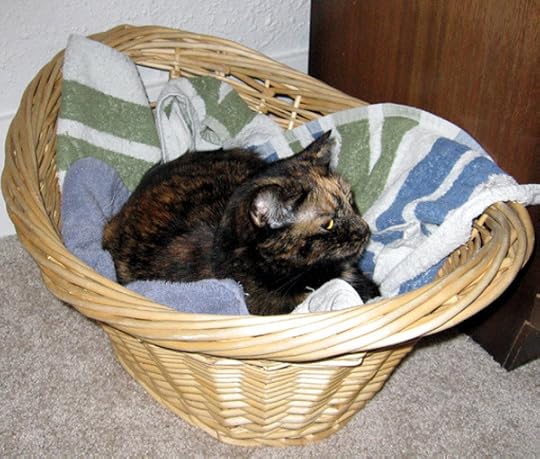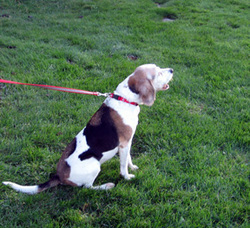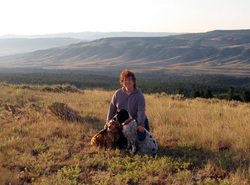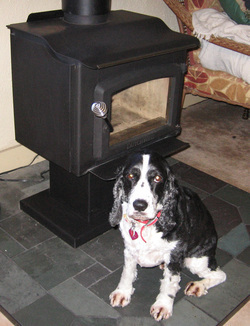Gayle Irwin's Blog, page 32
December 29, 2013
Lessons from Our Pets: Love and Loyalty
 Christmas is over. I enjoyed time with family and friends and much of that time was shared with my pets. -- and I still have a few days to be at home with them as we approach the New Year. My furry friends have been, and are, a constant reminder of what love and loyalty really are – the great comfort they bring when one has a stressful or difficult day, the joy they bring because they are always happy to see you, the solace they offer when you're ill, and the special companionship they give just simply by “being there.” Pets are truly amazing creatures!
Christmas is over. I enjoyed time with family and friends and much of that time was shared with my pets. -- and I still have a few days to be at home with them as we approach the New Year. My furry friends have been, and are, a constant reminder of what love and loyalty really are – the great comfort they bring when one has a stressful or difficult day, the joy they bring because they are always happy to see you, the solace they offer when you're ill, and the special companionship they give just simply by “being there.” Pets are truly amazing creatures!I have been a pet owner since childhood. Both cats and dogs have graced my life and my home. As a child growing up on an Iowa farm, I spent endless hours outdoors, taking care of the animals and walking the woods surrounding our place. Most times, either a dog or cat accompanied me. Those memories transcend time and impact my life today.
I have an office set up at home, a space I use for my writing projects. I am rarely alone in that room. Furry friends surround me: Cody snoozing on a dog bed a short distance from my desk, Mary lying near the office chair, and Murphy either lying right next to the computer or on her cat bed on top of the printer. Often in the midst of my concentration, I pause and glance over at one or all of them – they want to be where I am. Their loyalty and dedication rivals most human friendships … and their presence brings calm to my often chaotic life, especially when I face deadlines. Yes, pets can be a lot of work – walking the dog, entertaining the cat, taking care of them when they're sick (vet bills can be very expensive!), training, food, etc. … but what they give us in return is priceless!
What bonds a pet to a person? People are the caregivers of their pets, feeding, exercising, playing, petting, lounging; we are the guardians. The more one positively interacts with their pet, the stronger the bond. Loyalty is inherent, especially in a dog.
We can learn a lot from our pets, including lessons in loyalty and love. Broken relationships, greed, selfishness and other negative traits often found in humans are rarely displayed in our pets. There’s a saying that goes, “May I become the person my dogs thinks I am.” Such a plaque hangs on my wall. Such a philosophy reigns in my heart.
Published on December 29, 2013 17:35
December 19, 2013
Holiday Gift Giving for Your Beloved Pets
 Christmas is a’comin, and most of us know the excitement of children as the holiday approaches. Like kids, our pets also enjoy a few new toys, and what better time to give our pets a few special toys than the holiday of giving?
Christmas is a’comin, and most of us know the excitement of children as the holiday approaches. Like kids, our pets also enjoy a few new toys, and what better time to give our pets a few special toys than the holiday of giving? When you’re out shopping for the kids and other family members these final days before Christmas, don’t forget your beloved pet! Toys stimulate our pets’ senses and encourage them to exercise, thereby fostering great physical and emotional health. There are many wonderful pet toys, but there are also special factors to consider when purchasing a pet toy. Our primary consideration should be safety. Just as we want our kids to be safe with the toys they play with, so we should also want safety to be the number one factor when choosing our pet’s toys. Therefore, be sure to not give a toy that can be broken into pieces and potentially choked on or get stuck in your pet’s throat.
Toys should be durable and fun.
Here are a few ideas:
Kong toys – these great dog toys are made of hard rubber and can be filled with biscuits or a specialty-made ‘goo’ (like squeezable cheese from a can). This toy offers the thrill of “finding the scent” and an edible reward! It also provides your dog with chewable fun, saving your shoes and furniture! Kongs come in a variety of sizes so any dog can have great fun with this wonderful, sturdy toy! KONG also make wonderful toys for the felines of our family!
Rope toys – another great dog toy that allows you and your dog to play tug-of-war (or your dog and its other four-footed friend!). You can also play fetch with your dog using rope toys. Again, these toys are quite durable and will provide you and your dog with hours of endless fun and exercise!
Rubber balls and rubber rings – great for tossing and playing fetch with your dog. However, make sure that the toy is not too small for your dog’s mouth and that it won’t come apart easily, creating a choking hazard.
Plush and squeaky toys – these can also be used for tug-of-war or fetch; sometimes dogs just love to chew on them. However, choking hazards to be aware of with these toys include choking on the interior stuffing so you need to monitor your dog with these types of toys.
Play mice – cats LOVE these toys, especially the play mice dipped in catnip (some dogs like them, too, so watch for that!). Some of the mice are made with a string so you and your cat can play “catch-me-if-you-can”; cats love to stalk things, so this type of game engages your cat’s ‘wild spirit’ so to speak (think of a bobcat stalking and pouncing on a rabbit).
Laser pointer – cats enjoy chasing the little red dot around (just make sure you don’t shine it in their eyes!). Again, think cougar in the wild, stalking, chasing, pouncing.
Small balls – cats enjoy batting and chasing things, and there are rubber and other types of balls created just for them. However, since these toys are small, you’ll need to keep close watch to make sure other pets (like dogs) and your children don’t pick up these toys and put them into their mouths.
Feather-and-pole toys– these toys provide times of fun for both cat and cat owner plus gives your feline great exercise with the jumping, batting, and catching that goes on. The feathers stimulate your cat’s sense of prey, and you can sit in your favorite living room chair and give your cat the exercise it needs and the fun it enjoys!
There are many wonderful toys available for pets and pet owners to enjoy together, or for the pet to enjoy by itself. So, when you’re out and about doing your holiday shopping these next few weeks, remember your special pet and the love and devotion it gives you… so, don’t forget to put a wonderful toy or two into your pet’s Christmas stocking this year!
May you, your family and your beloved pet enjoy a safe and special holiday season!
Published on December 19, 2013 18:59
December 6, 2013
Pets as Gifts - Not the Best Idea
 Christmas is a time for family and friends. It's also a traditional gift-giving time, and sometimes those gifts are living beings.
Christmas is a time for family and friends. It's also a traditional gift-giving time, and sometimes those gifts are living beings.People often consider giving, and often do give, pets as Christmas presents. However, there are many good reasons why this is not a good idea:
The holiday season is a busy one for most people. Bringing into the mix a new pet can elevate stress, and the animal, after the initial “ooh” and “ahh,” can be neglected – not good for the pet and not good for the people because a neglected pet can be vocal and destructive.
Giving a child a new puppy, kitten, dog, or cat and expecting the child to be responsible for the pet is not wise either. If you're thinking of giving your child(ren) a pet this Christmas, you as parent and adult need to recognize and accept responsibility for the animal's care. Although it's wonderful to teach children responsibility, “teaching” is the operative word: don't expect the child to always be the one to feed, water, exercise, change litter boxes, etc. – and remember pets need vet care. Consider pet ownership a family affair, with parents being the primary caregivers and outlay of money.
If you're thinking of getting a pet for a friend or loved one who doesn't live with you, talk with that person first and MAKE SURE they want a pet... and what type. Perhaps the person receiving the pet doesn't have the time to devote to an animal even after Christmas due to work schedules and extra activities. “Surprising” someone with a pet that's not really wanted is again a bad idea for both person and pet. If having a pet is something the person would want and accept, offer to pay the adoption fee for the animal. You can create a lovely “gift certificate” for your friend or family member and let them choose the animal that is right for them.
Other ways to “give”:
Volunteer with the local rescues, Humane Society, or animal control as a family during the Christmas break. Walk dogs, play with cats, donate supplies – give of your time and your treasures as a family to help animals in need.
While visiting with the animals, you will be able to interact with them and decide as a family which pet is the right fit for you. Acquiring a pet shouldn't be a spur of the moment, whimsical, decision. Spend time with the dogs and cats, learn their personalities, quirks, and good traits – by spending time with them, you will get to know which one fits your family situation best.
Research breeds. There is a lot of information online, including the American Kennel Club's website ( www.akc.org ) for dogs and this Petfinder site for cats: http://www.petfinder.com/cat-breeds where you can learn about specific breeds and discover one that fits best with your family situation and lifestyle.
Many animal welfare organization participate in the national program “Home for the Holidays,” hoping to increase adoptions and adoption awareness during this special season of the year. But, pets shouldn't be thought of as disposable temporary residents – they need loving, safe, permanent homes. Therefore, thoroughly think through the decision to adopt a pet or to give one as a gift.
Pets give so much to people – friendship and devotion at the top of the list, and it may seem like a natural fit to bring those great traits into a household this month. During this season of good cheer and great busyness, while it may be tempting to give a pet as a gift, look at other options and opportunities to help animals in need so that when a pet goes “Home for the Holidays”, it's going home permanently with people who want to and have time to love and care for it. After all, we receive so much from our pets – shouldn't we give them all that they need without hesitation as well?
May you and your family and all your furry friends enjoy the merriest of Christmases this year!
Published on December 06, 2013 07:47
November 28, 2013
Holiday Pet Safety Tips
 Like an autumn sunset disappearing on the horizon, 2013 is quickly fading. Halloween recently transpired, Thanksgiving is taking place the day of this post, and Christmas beckons on the calendar. Pets often are forgotten in the hustle and bustle of the holidays, which can make for a more stressful season for them and for their humans. Therefore, make it a point to remember your pet and help keep him/her safe this holiday season by considering the tips outlined below:
Like an autumn sunset disappearing on the horizon, 2013 is quickly fading. Halloween recently transpired, Thanksgiving is taking place the day of this post, and Christmas beckons on the calendar. Pets often are forgotten in the hustle and bustle of the holidays, which can make for a more stressful season for them and for their humans. Therefore, make it a point to remember your pet and help keep him/her safe this holiday season by considering the tips outlined below:Be aware of where your pets are as you and your family and friends come and go. Pets can zip out doors very quickly. You may want to put your pet in an extra bedroom or the laundry room if you expect your door to be opening and closing a lot on a particular day or on the day you host a party or open house.
Make sure your pets have collar and ID tags in case they rush out the door and become lost. ID tags are vital to getting your pet returned home quickly. You may also want to invest the small amount of money it costs for your vet to implant a microchip. Collar and tags can become lost themselves, and pets turned into the local animal shelter are scanned for microchips. Also, remember keep that identification up-to-date.
Food is a prime part of the holiday season. However, there are many people-food items that are health hazards for our pets. For example, don’t give your pets turkey or chicken bones or rich foods like gravy or sweets such as chocolate. Keep your pets’ food routine the same during the holidays as ‘regular days’ thereby avoiding upset stomachs or worse.
Decorations are also a part of the holiday season, but many can cause issues for our pets. Garland and tinsel, for example, entice cats and may be ingested, creating health concerns. Candles can be knocked over by either people or pets. Therefore, when using decorations, choose those that pose less danger to your pets and your household in general.
Similarly, some plants pose health hazards for our pets, including mistletoe and poinsettia. Keep these out of your pets reach or consider purchasing artificial ones.
The excitement, busyness and stress we experience during the holidays, as well as the extra people in the house during Thanksgiving and Christmas, can also stress our pets. Create a quiet place for your dog or cat to go and get away from the hustle and bustle. Set up a room in the house away from the noise that has things your pet is familiar with: your pet’s bed or special blanket, its toys, and its food and water dishes. Our pets need a peaceful place where they are comfortable and secure as we are milling around doing all those things that make the holidays special!
Don’t neglect your dog’s daily walk and your cat’s playful exercise. Our pets need their daily routine, not just for emotional stability, but also for their overall physical health – just like we do!
After returning from a walk, clean your dog’s paws of the ice, snow and other materials picked up along the way. Snow and ice can be painful on pet paws, and material such as ice melt for sidewalks may be ingested by your pet as s/he cleans itself, causing medical issues. Do the paw cleaning for your pet for better safeguards.
Also, remember that anti-freeze is poisonous to pets, so keep your animals away from it.
By following these tips, you and your pet will more greatly enjoy the holiday season!

Published on November 28, 2013 15:00
November 12, 2013
The Joy of Living with Seniors
 Call our house the ‘geriatric home for pets: Cody, our cocker spaniel, is more than 15 years old, and Mary, our springer, will be eight in February. Even our two sister cats are considered seniors these days, turning eight last August. We are all enjoying these “retirement years” in spite of some health challenges.
Call our house the ‘geriatric home for pets: Cody, our cocker spaniel, is more than 15 years old, and Mary, our springer, will be eight in February. Even our two sister cats are considered seniors these days, turning eight last August. We are all enjoying these “retirement years” in spite of some health challenges.I know all about health challenges in seniors – especially people. My parents, in their mid-70s, have experienced some significant health issues these past few years, including a recent knee replacement for my mother. Just like with senior humans, there is challenge at times with senior pets. However, there is also great joy!
November is National Adopt a Senior Pet Month, and in honor of this special month, I wanted to point out some great reasons for bringing an older, more mature pet into the household:
Puppies and kittens require a great deal of attention and time, and for busy families, time is something of a commodity. Mature pets can be left alone for longer periods of time, and often enjoy having ‘down time’. Now, this doesn’t mean they should be locked up in a kennel all the time and it doesn’t mean they don’t need exercise – adult pets just require LESS time and energy than puppies or kittens.
Young ones require training, such as housebreaking, and a great deal of patience. Older pets often come housebroken/litter box trained, and in many cases, adult dogs have some basic obedience training, such as knowing “sit”, “stay” and “come”.
What you see is what you get when you adopt an adult – adopting a mature pet allows you to know more about its size and temperament, whereas adopting a puppy or kitten is sometimes a guessing game when it comes to the animal’s temperament and size.
Older pets expend less energy – often, a simple walk around the neighborhood for an older dog is sufficient, and mature cats enjoy lounging in the sun more than chasing strings or feathers. So if you’re not terribly active, an older pet might suit your lifestyle.
If you are an active person, such as a hiker or runner, your best companion could be a 2- to 5-year-old dog who is just waiting for that energetic person to help HIM expend some energy! (plus, most likely, not in need of potty training!)
Adopting an older pet is truly a selfless act. As an animal ages, its chances of adoption grow slimmer; by giving a mature pet a home, you’re showing great compassion and empathy – and gaining a wonderful furry friend in the process!
Some people think if an older dog or cat is in the shelter there must be something wrong with it – not so! Many adult and senior pets are relinquished because the owner can no longer care for them due to the person’s health or even death. Some of the most wonderful companion animals in need of new homes are awaiting another chance to shower a family or individual with devotion, just as they did with their previous owner.
In my professional and personal life I’ve heard the “oohs” and “ahhs” regarding puppies and kittens, and the toutings of human parents who say “I want a puppy or kitten to grow up with my kids.” Truthfully, age makes no difference when it comes to humans and pets bonding – Cody was nearly 10 when we adopted him, and he is completely devoted to my husband and I – he even tolerates the cats! Cody has been with us for more than five years, and we don't regret bringing him into our household, even in the midst of a health challenge, just as we don't regret helping to care for our aging parents. In many ways, we saved Cody's life, and he has certainly enriched ours! When his little cocker head lays on my lap or his tan-colored body stretches on near me while on the couch and he looks at me with adoring eyes, my heart simultaneously melts and sings!
So, if adding a new pet to your home is on your ‘to-do list’ this month, consider adopting an adult or senior pet – you, too, can know the joy of hanging out with an adoring, mature four-footed friend and giving that adult pet a special, loving retirement home!
Published on November 12, 2013 06:11
October 31, 2013
The Chronicle and Care of Kitties
 It’s often their eyes, jade green or amber gold… Sometimes it’s their friendliness, rubbing against ankles and legs… It may even be their purring motors, soothing and loving as they snuggle into your neck. Whatever the “it” is, cats capture our attention and hearts.
It’s often their eyes, jade green or amber gold… Sometimes it’s their friendliness, rubbing against ankles and legs… It may even be their purring motors, soothing and loving as they snuggle into your neck. Whatever the “it” is, cats capture our attention and hearts.Cats and humans have interacted for thousands of years. According to the American Society for the Prevention of Cruelty to Animals (ASPCA), the African wildcat became a frequent and welcome visitor to human habitation, attracted to, and preying upon, rodents that fed on stored grain. Cats also played an important part in Egyptian culture, often being mourned upon demise; cat mummies have been found in huge numbers in this part of the world. Short-haired cats arrived in Italy more than 2,000 years ago and reached England 300 years later. During the Renaissance cats appeared in paintings and literature as objects of affection, raising their status as household companions. Cats were later taken across the Atlantic Ocean to America and spread across the continent.
Although cats often survived simply on rodents during their earlier history, people today care for their cats much like dogs, providing food, shelter, vet care, and affection. Yet, cats seem to be considered more disposable than dogs, with only two percent of lost kitties being reclaimed by their owners. Each year shelters and rescues across the country take in about four million cats; more than 70 percent are euthanized, according to American Humane.
Many types of cats are brought into shelters. Some are purebred, such as Siamese or Persian, while others are typical tabbies. Some are kittens, some are adults, and others are seniors. About 25 percent of cats entering animal shelters are adopted.
No matter the age, type or sex, all cats need compassion and care. From nutrition and attention to exercise and veterinary care, our cats depend on us to ensure their health and happiness.
Caring for cats can be easier than caring for dogs. Fido, for example, needs his daily walk; cats are content with a catnip mouse or scrunchy ball to bat around. Litterboxes serve as lawns, and dry food can be left out for kitty to nibble on throughout the day. However, vet care is just as important as it is for dogs, from vaccinations against diseases like rabies to spaying and neutering to prevent additions to the pet overpopulation problem.
For more information on various cat care topics, visit the ASPCA website: http://www.aspca.org/pet-care/cat-care
November is Adopt a Senior Pet Month – many older cats find themselves in shelters and rescues because they are lost or because their family can no longer care for them. Consider giving an older cat a home this month and help alleviate the pressure on our rescues and shelters.
There are many benefits to adopting an older cat, including:
Adult cats get into less mischief than kittens.
They are also less maintenance.
Senior cats have come from a home – perhaps their owner died or became gravely ill – and therefore, “know the ropes” of household living… including warming one’s lap!
Adult cats are more independent and make great pets for people who work outside the home.
The majority are litter box trained.
Mature cats are less likely to be adopted; therefore, you could be saving a life!
Look into those big, bright eyes and hear that heartfelt purr – consider adopting an older cat this month and giving a special kitty all the care it needs… and you’ll receive lots of love, devotion, and joy in return!

Published on October 31, 2013 20:21
October 20, 2013
Give a Bit of Time to Help Animals in Need
 Animal welfare organizations, whether rescue groups such as the many breed rescues or animal shelters in your community and mine, need volunteers. From people to help with fundraisers, to fostering animals that are waiting for new homes, from walking dogs and brushing cats to helping transport pets to their new homes, volunteers provide many and varied services. This month is National Adopt-A-Shelter Dog month, providing a great opportunity to help animals in need in and around our communities.
Animal welfare organizations, whether rescue groups such as the many breed rescues or animal shelters in your community and mine, need volunteers. From people to help with fundraisers, to fostering animals that are waiting for new homes, from walking dogs and brushing cats to helping transport pets to their new homes, volunteers provide many and varied services. This month is National Adopt-A-Shelter Dog month, providing a great opportunity to help animals in need in and around our communities.I enjoy helping animals, but there is a limit to what I can do. Yet, with that limit, I have found a few spaces I can fill. For example, I assist my local humane society with fundraising events, particularly by selling my books and donating a percentage back. I also help transport dogs for various rescue organizations. I’ve transported large, medium and small dogs, and each transport has given me not only great satisfaction in assisting an animal in need, but also touched my heart with the pet’s special story.
Recently, I had the honor of transporting an older beagle named Boone to his permanent home. I often travel to Montana to visit my parents, and I happened to be doing so this particular weekend, with a planned stop over at one of my most favorite places in the world: Yellowstone National Park. Boone's new family lives in Yellowstone, so I was able to transport this sweet, older gentlemen the entire way to his new home. What a joy to bring this lad into the loving arms of his awaiting family -- I know he will enjoy the sights and smells of America's first national park!
Volunteers are vital to rescue and other animal welfare organizations. There are many ways a person can volunteer. Some of these endeavors take lots of time, others take only a few hours a week, and some just a few hours every few months (like transporting). Here are some ways in which you can help animal rescue and welfare organizations as a volunteer:
Donate time to walk and play with dogs.
Donate time to brush and play with cats.
Serve as a foster parent, providing a temporary home to injured or orphaned animals, those awaiting a new home, or mothers with very young kittens or puppies.
Transport pets going to new homes.
Assist with fundraising and other special events.
Serve as a board member.
Help landscape and/or clean the facility.
Donate products, such as pet food, toys, treats, laundry soap and cat litter.
Donate money and/or recycle items such as aluminum cans and donate the proceeds.
Why not take this month as attention is turned to shelter dogs and give a bit of yourself to assist in some way? Visit with someone at your local animal shelter or rescue organization and see what their needs are. Perhaps make it a family affair and spend a Saturday or Sunday afternoon at the shelter or rescue helping with newsletter mailings, dog walking, cat play time, or whatever else the group needs regarding volunteers.
You will be amazed at the difference you can make in the lives of pets who need help by donating just a few hours a week, a few hours a month, or several hours twice a year. Share the love and be part of the positive solution by giving of yourself to help pets still awaiting adoption -- your heart will soar knowing you've helped to make a difference!
Published on October 20, 2013 19:47
October 6, 2013
Adopt a Shelter Month: Be a Super Hero!
 Animal welfare groups across the country, including many of the local rescue organizations and animal shelters in my community, celebrate the joy of dog adoption this month. October is recognized as national Adopt-a-Shelter-Dog Month and offers a wonderful opportunity to give a dog a new, loving home.
Animal welfare groups across the country, including many of the local rescue organizations and animal shelters in my community, celebrate the joy of dog adoption this month. October is recognized as national Adopt-a-Shelter-Dog Month and offers a wonderful opportunity to give a dog a new, loving home.Promoted by the American Humane Association and the American Society for the Prevention of Cruelty to Animals (ASPCA), Adopt-a-Shelter-Dog Month brings greater awareness to the plight of homeless dogs throughout our nation. Animal welfare organizations estimate nearly that three to four million dogs and cats enter shelters across the United States annually; nearly half are killed. Adoption saves lives.
If you are considering adding a dog to your household, this is a good time to do so! Dogs are loyal and loving, providing that special ‘sidekick’ for life’s journey. Many dogs enjoy riding in the car, going for walks and hikes, and simply being a part of a family; therefore, they make wonderful companions. And remember the great health benefits dogs can provide: reducing stress and blood pressure and uplifting our moods, among others.
Whether you are single, married, have children, or are retired, there’s a dog to fit every lifestyle. Of course, you need to find the RIGHT dog, and that’s one of the services animal shelters, rescue organizations, and humane societies provide. The staff and volunteers who spend time with the animals know their personalities and may often know the dog’s background; therefore, these groups offer a tremendous service for those hoping to add a dog to their life.
Consider being a superhero today: save a life of and bring home your own special sidekick! Adopt a dog in October during national Adopt-A-Shelter-Dog Month. And even if you can’t adopt a pet, there are many things you can do to show kindness and compassion: support your local pet rescue and shelter organizations with donations not just of money, but also of dog toys, treats, food and even your time. Volunteers are vital to animal rescue organizations and the simple act of walking and socializing a dog can help alleviate a shelter dog's loneliness and help it find a home sooner
Dogs need people – they need our care, compassion, time, and attention. Be a Super Hero this month!
Published on October 06, 2013 21:10
September 22, 2013
Fire Safety Tips for You & Your Pets
 As we gear up for colder weather, some of us operate woodstoves and fireplaces in our homes. We also often enjoy the warmth and coziness of flickering candlelight. Such warmth can also be destructive. National Fire Prevention Week is Oct. 6 – 12, 2013. Thousands of pets die because of fire every year. Just as we plan for evacuations of our human family members in case of fire, we should also prepare to help the furry ones who share our homes.
As we gear up for colder weather, some of us operate woodstoves and fireplaces in our homes. We also often enjoy the warmth and coziness of flickering candlelight. Such warmth can also be destructive. National Fire Prevention Week is Oct. 6 – 12, 2013. Thousands of pets die because of fire every year. Just as we plan for evacuations of our human family members in case of fire, we should also prepare to help the furry ones who share our homes.Make sure you have smoke alarms in your home and that those alarms have working batteries in them.
Designate one person in the family to be responsible for each pet in the event of an emergency. For example, Dad is responsible for the dog, and Mom is responsible for the cat.
Alert firefighters to the fact you have pets living in your home. This can be done with a Pet Rescue Fire Safety Sticker in your window (see the end of this article on where to find these). Such decals stick to your front window, alert emergency crews that you have pets in the home (and how many and what kind), and tell firefighters to “rescue my pets!”
Keep outdoor pet houses and pens away from brushy areas. Fire departments warn people to clear dry brush away from homes -- that also applies to your pets. For example, if you have a doghouse or rabbit hutch, make sure it’s at least 20 feet away from any brush that could possibly become fire fuel. Doing this can provide you with time to go out and rescue your pet if a fire threatens your property.
Know their hiding places. During a fire, your pets will be terrified, and they’ll most likely run to the places they feel most safe. If you don’t know their common hideaways, you could run out of time to save your furry friend. One suggestion: find all the small areas and places you know to which your pet likes to get away (such as under the bed or in the laundry room closet), map them out on a piece of paper, and include that map in your fire escape plan.
Have a plan! All families should have an evacuation plan in case of fire; include your pets in that plan. An integral part of it should be keeping collars and leashes near doors so you or the firefighters can grab them quickly during a rescue.
Take your furry friend to the vet as soon as possible. Pets can suffer from serious smoke inhalation in just a short time and they may also have burns underneath their fur, feathers, or feet.
Before such an emergency breaks out, take a check around your home for potential fire hazards your pet might inadvertently get into, such as stove knobs, loose wires and electrical cords. Don’t leave pets unattended around open flames and make sure to properly extinguish fires before leaving your home.
Keeping your family, including the furry ones, from fire harm is critical, so ensure to the best of your ability everyone’s safety. National Fire Prevention Week is a good time to consider the fire hazards around your home and doing whatever you can to prevent such an emergency.
Find Pet Alert Rescue Window Stickers at these and other online sites:
PetCo: http://www.petco.com/product/117629/Pet-Safety-Alert-Rescue-Rover-Pet-Alert-Fire-Rescue-Decals.aspx?Ntt=fire%20safety&OneResultRedirect=1
Amazon: http://www.amazon.com/s/ref=nb_sb_ss_c_0_17?url=search-alias%3Dpets&field-keywords=pet%20rescue%20decals&sprefix=pet+rescue+decals%2Caps%2C236

Published on September 22, 2013 06:41
September 9, 2013
Celebrate Dogs During National Dog Week
 Pet owners don’t need a special time to honor and celebrate their pets, but throughout the year there are various recognitions in honor of pets. For example, the second week of May is Be Kind to Animals Week, the month of June is Adopt-A-Shelter-Cat Month, and November is Adopt-A-Senior-Pet Month. The last week September is considered National Dog Week, when dog owners and various organizations honor dogs.
Pet owners don’t need a special time to honor and celebrate their pets, but throughout the year there are various recognitions in honor of pets. For example, the second week of May is Be Kind to Animals Week, the month of June is Adopt-A-Shelter-Cat Month, and November is Adopt-A-Senior-Pet Month. The last week September is considered National Dog Week, when dog owners and various organizations honor dogs.William Judy, who started Dog World Magazine in the 1920s, first set aside this special week as a way to celebrate those special creatures deemed “man’s best friend”.
The American Kennel Club ( www.akw.org ) honors both dogs and owners during National Dog Ownership Responsibility Day. The AKC is hosting a major event in North Carolina on September 21, and various AKC organizations will host activities highlighting the joy (and responsibility) of owning a dog throughout September. People and organizations can register the many activities they do with their dogs to impart responsibility. To learn more, visit http://www.akc.org/clubs/rdod/index.cfm.
In my community, we're having a Pet Fest on Saturday, Sept. 14. The Central Wyoming Kennel Club will be there as well as many other organizations and people who love dogs.
Dogs have served humankind for thousands of years, from protector to bearer of burdens. Native Americans, for example, used dogs to transport loads prior to the horse. Still today, dogs serve people in a variety of ways: herding and protecting flocks; finding fowl in the field; guiding the blind; assisting deaf and wheel-chair bound individuals; rescuing lost children; and bringing smiles to those in hospital beds. Here’s a quick look at some of the ways dogs help people:
Assistance dogs are specially trained to help people manage physical or emotional disabilities. Guide dogs assist the blind, deaf assistance dogs alert people to the telephone or doorbell, and assistance dogs help those in wheelchairs open refrigerators and building doors.
Search and rescue dogs look for the lost. From hikers and skiers to victims of the 9-11 terrorist attacks, these hero dogs put their health and life in the balance in the line of their duty.
Military and police dogs also put their lives on the line. From sniffing for drugs or bombs to patrol duties, these dogs serve our country in the United States and abroad.
Visiting hospitals and nursing homes, therapy dogs bring smiles to the faces of ill children and lonely senior citizens.
Read-to-the-dog programs are popular in many libraries across the country; these programs help children become better readers for they aren’t as nervous reading to dogs as they are reading with adults. The Butte Public Library, for example, has a program called Paws for Reading, at which time children interact with special visiting dogs.
Sporting dogs, including spaniels, retrievers and pointers, help bring home dinner in the form of ducks, pheasants, and partridge,
Herding dogs, like the Australian Shepherd and the Old English sheep dog, have the genetic instinct to drive and gather livestock. Historically, they have been used to assist shepherds and farmers; many of these dogs, such as the collie and the Canaan dog, have been used for centuries.
A variety of dogs are working breeds, including the Siberian husky and the Bernese mountain dog. Others, including German Shepherds, Akitas, and Doberman pinschers, help protect people and property.
Dogs help people in many ways, including the simple acts of helping us exercise, lowering our blood pressure, and getting us to laugh and smile more often. So, honor your special pooch during National Dog Week with an extra ounce of kibble, a special hug, or a day outdoors in the field. And, consider attending a special event near you for Dog Ownership Responsibility Day.
Also, remember those wonderful canines you don’t know, like those that search for lost hikers, those who dig skiers from avalanches, those which have given their lives sniffing for bombs, dogs that bring a smile to a grandfather’s face when visiting the nursing home, and dogs that spend time in libraries listening to children hesitantly read aloud… dogs in service to others for the sake of all.
Published on September 09, 2013 09:04



